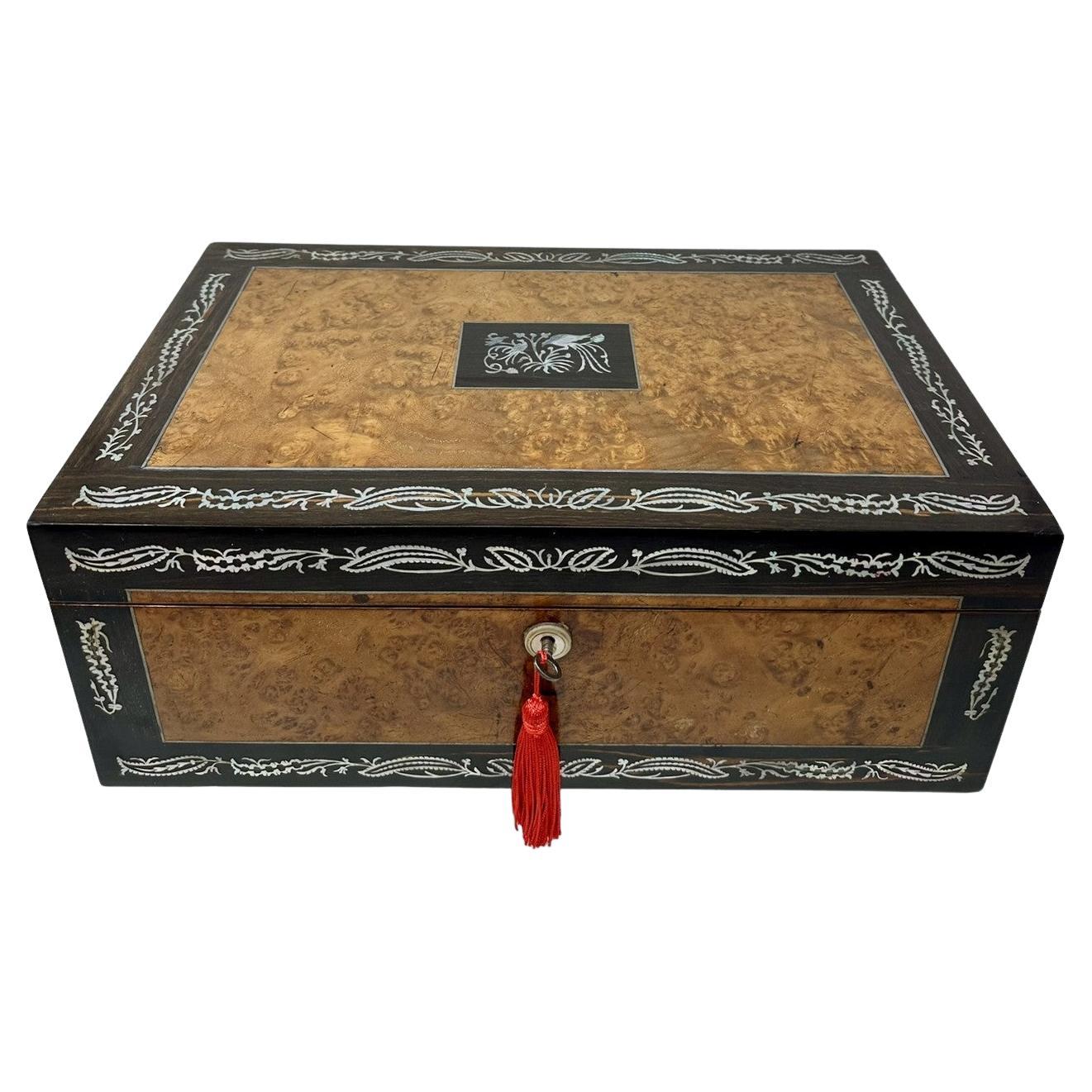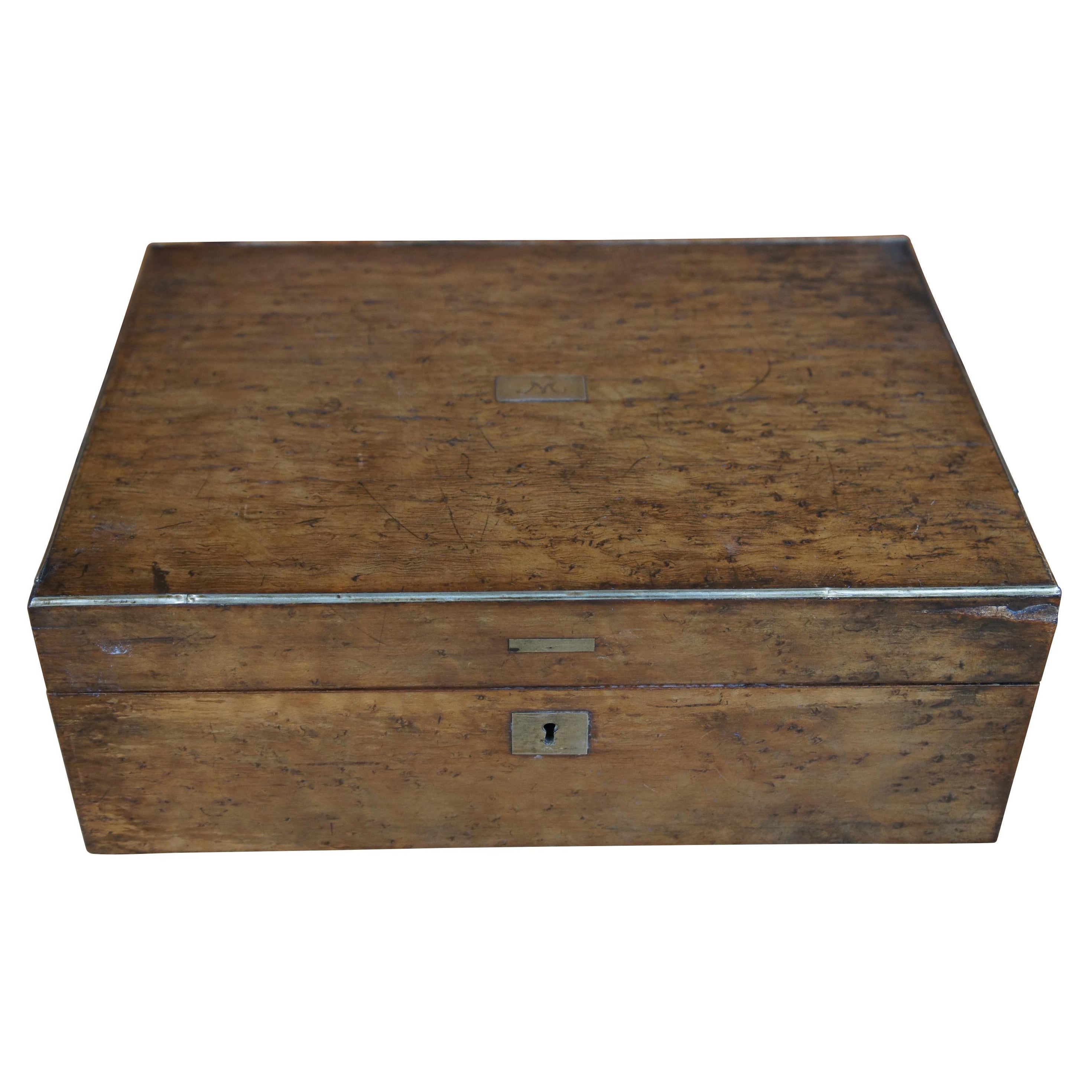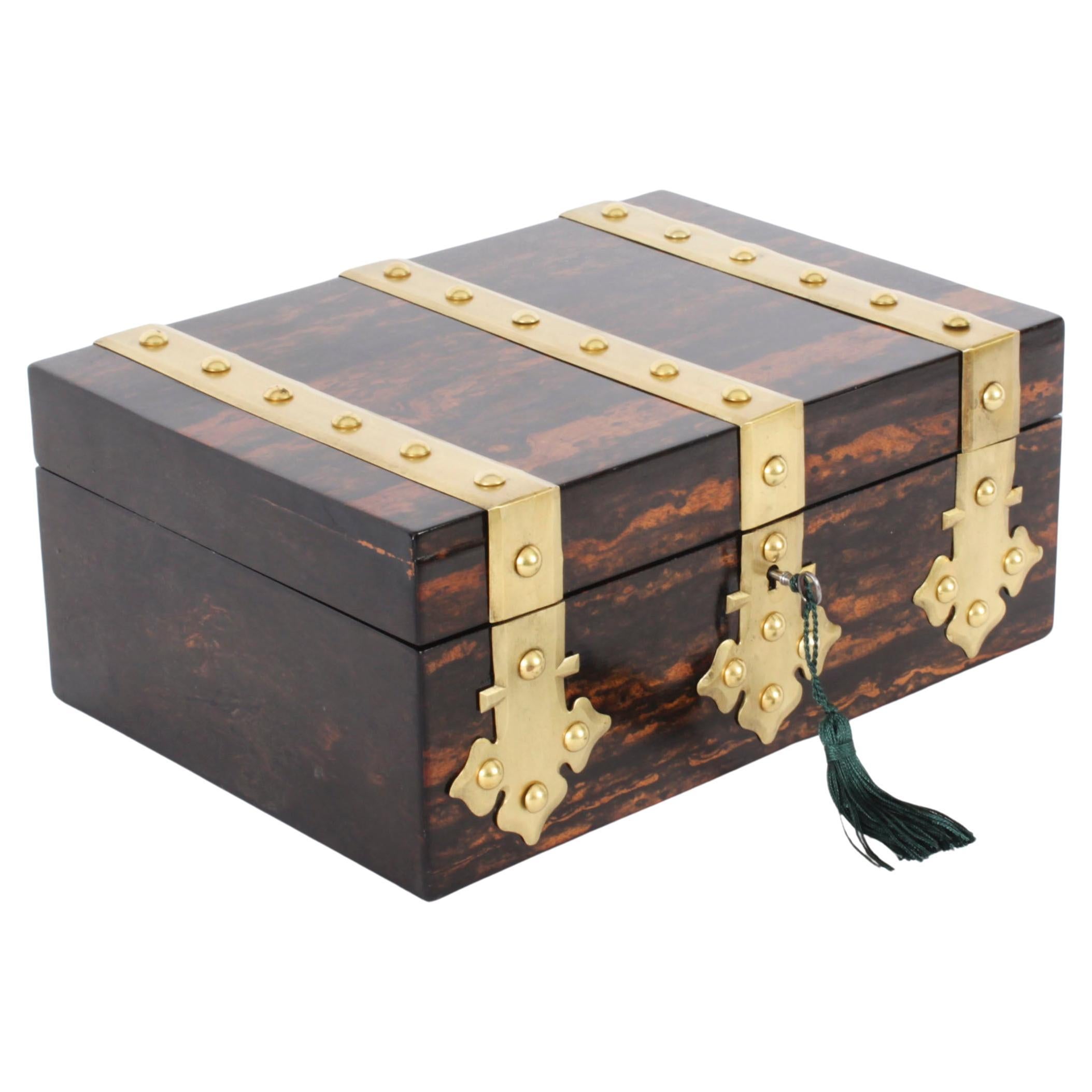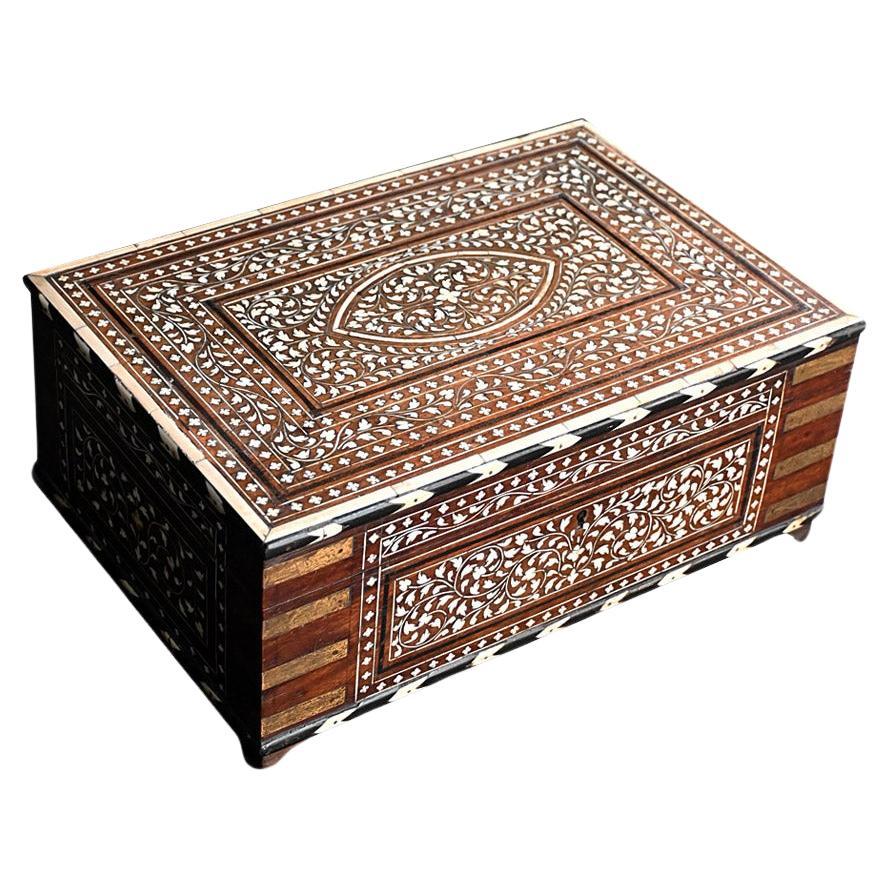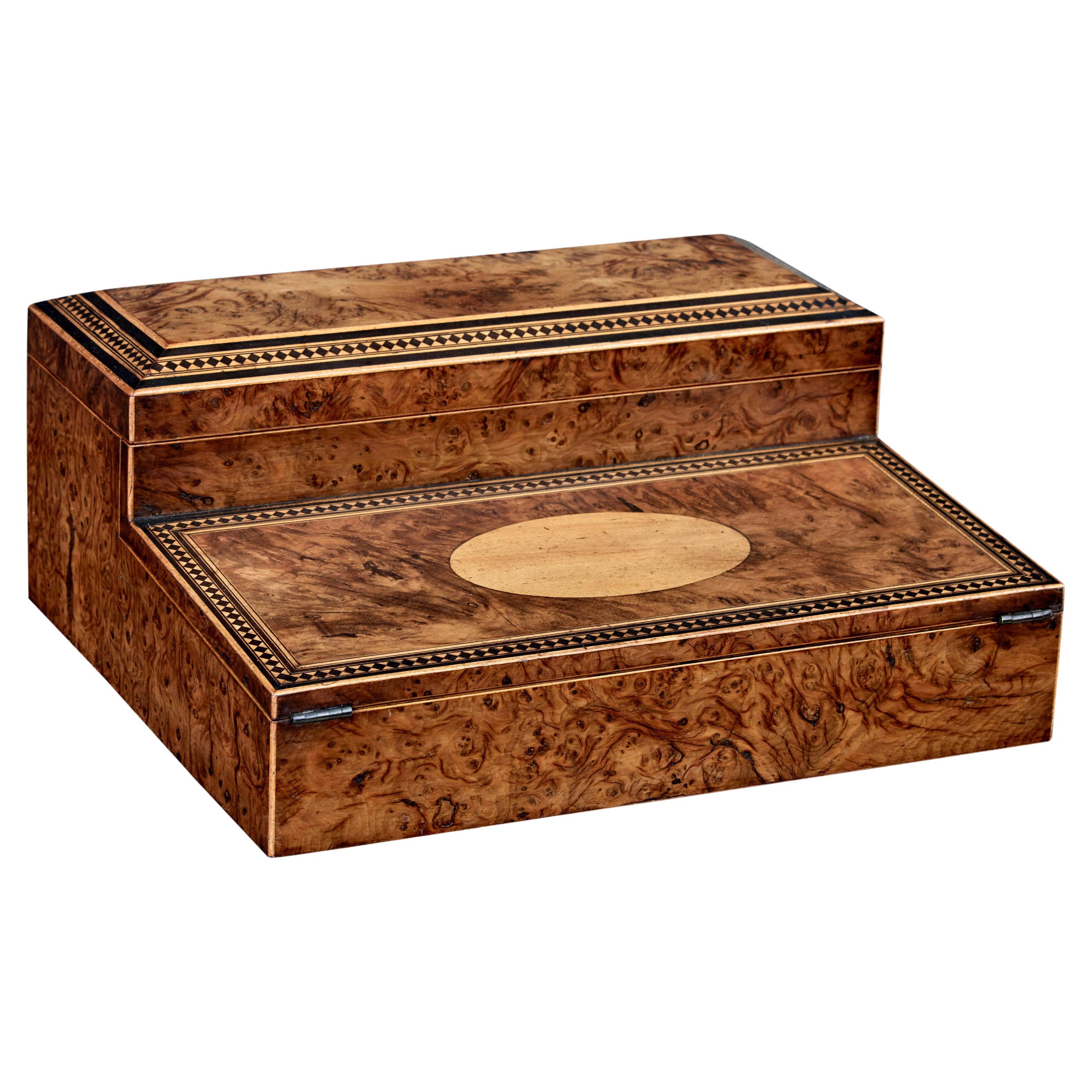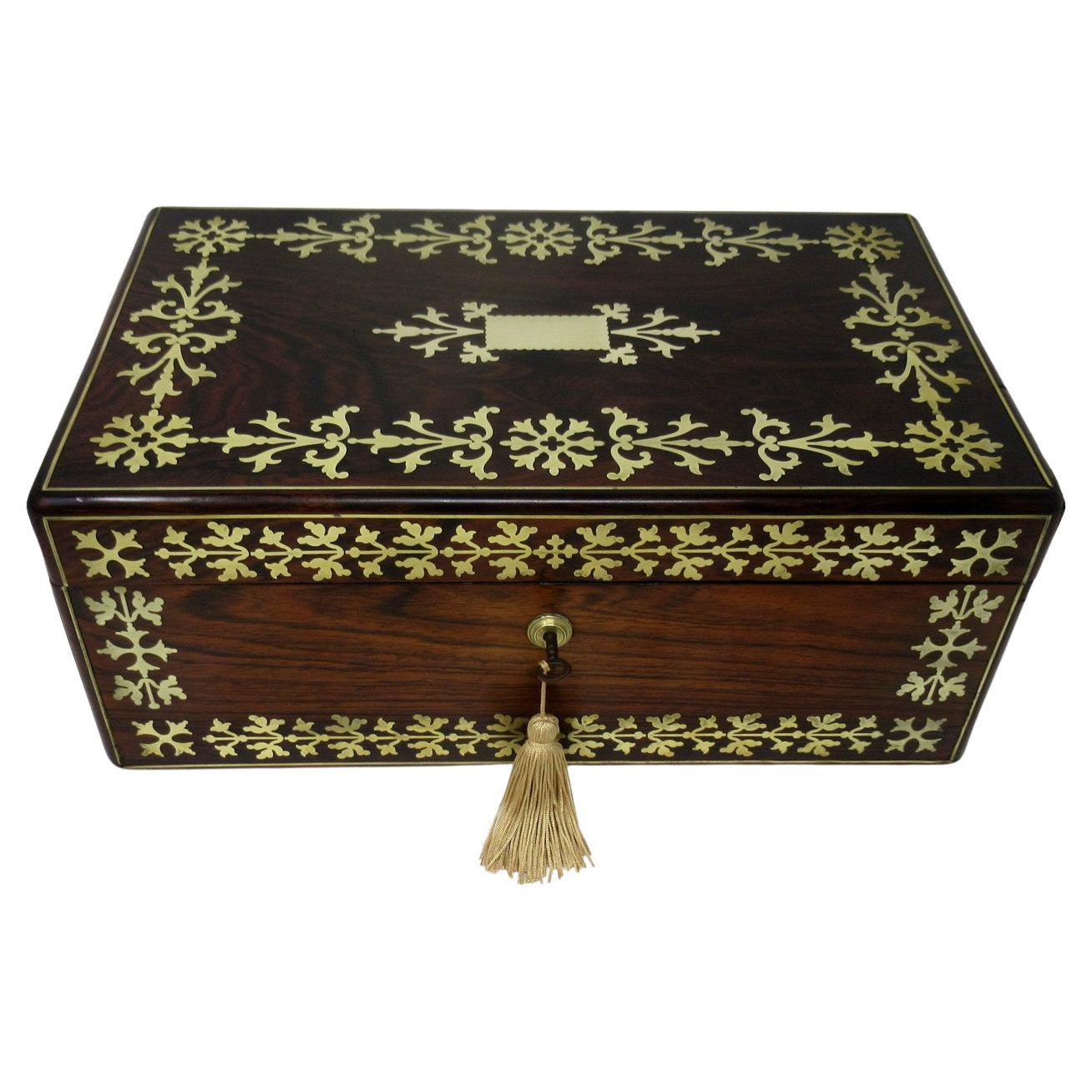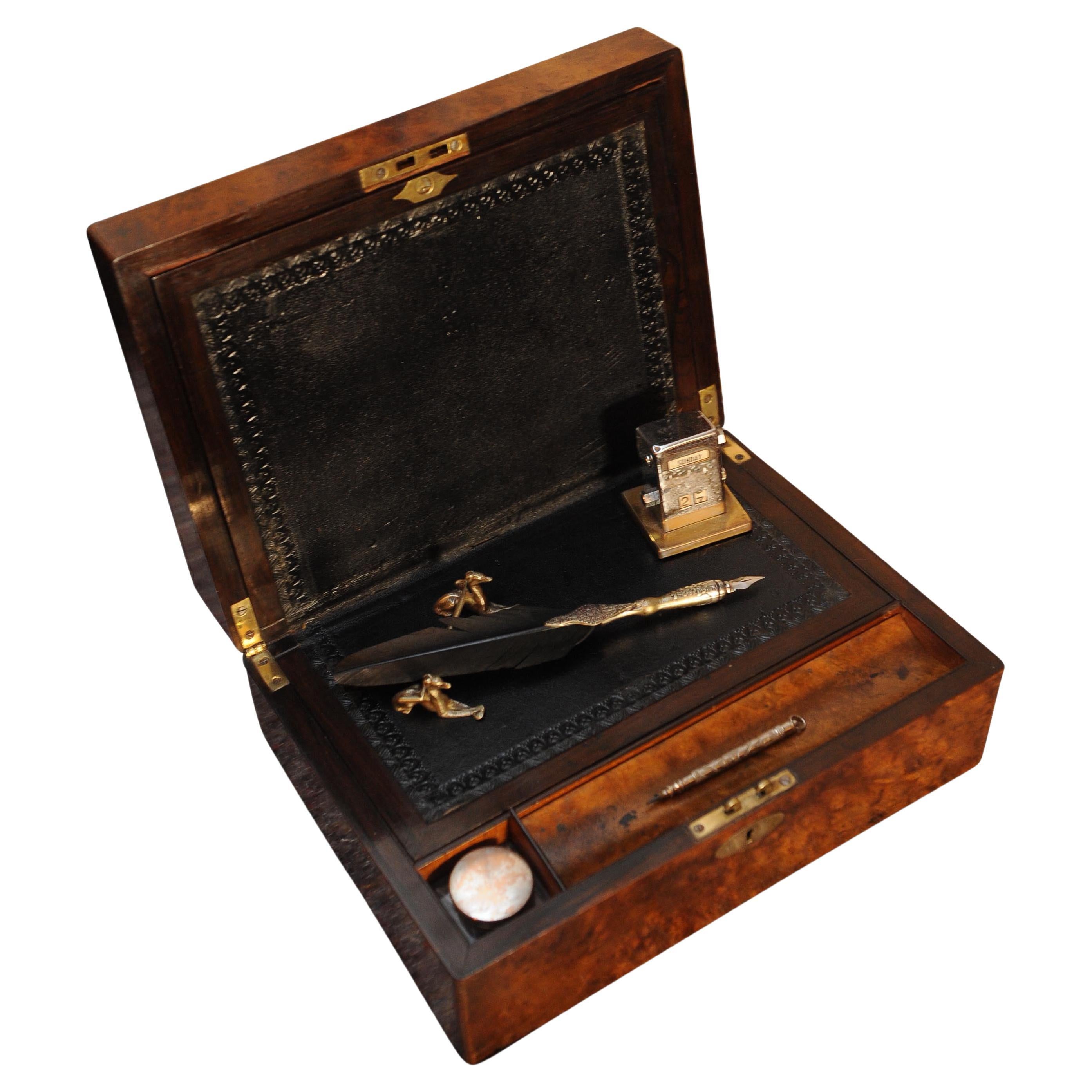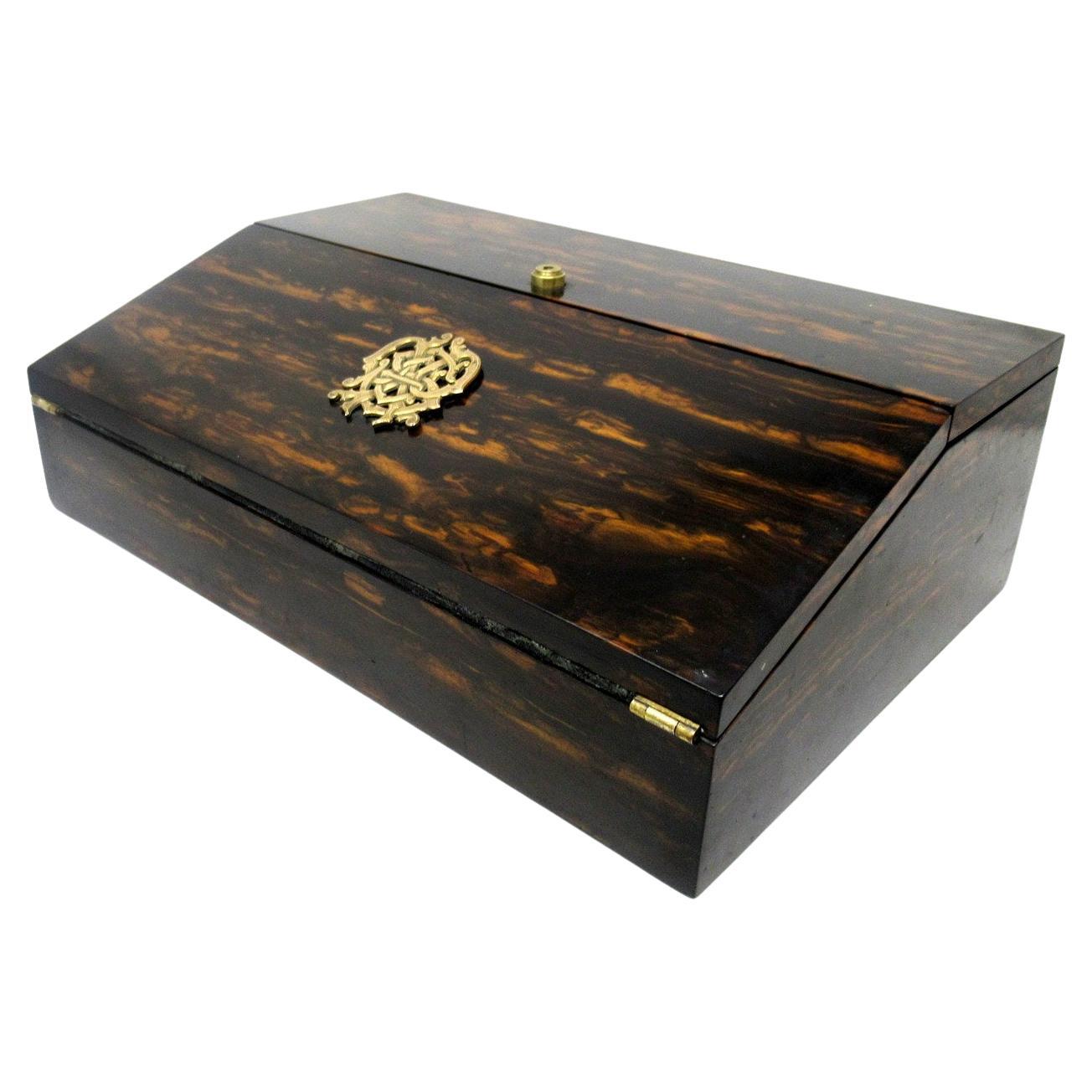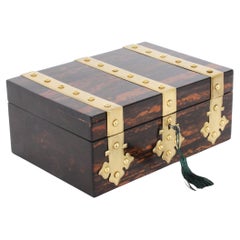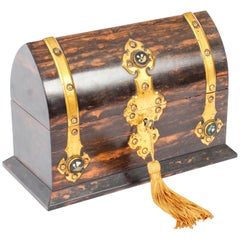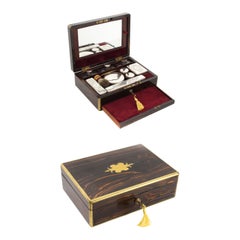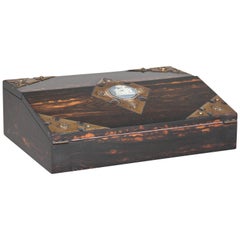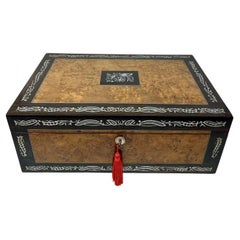
Antique Coromandel Brass & Pewter Inlaid Writing Slope, 19th Century
View Similar Items
Want more images or videos?
Request additional images or videos from the seller
1 of 18
Antique Coromandel Brass & Pewter Inlaid Writing Slope, 19th Century
About the Item
- Dimensions:Height: 5.12 in (13 cm)Width: 11.42 in (29 cm)Depth: 7.49 in (19 cm)
- Style:Victorian (Of the Period)
- Materials and Techniques:
- Place of Origin:
- Period:
- Date of Manufacture:circa 1860
- Condition:
- Seller Location:London, GB
- Reference Number:Seller: 09959b1stDibs: LU950617330712
About the Seller
5.0
Platinum Seller
These expertly vetted sellers are 1stDibs' most experienced sellers and are rated highest by our customers.
Established in 1983
1stDibs seller since 2012
1,198 sales on 1stDibs
Typical response time: 1 hour
Associations
LAPADA - The Association of Arts & Antiques Dealers
More From This SellerView All
- Antique Figured Coromandel Brass Box / Casket 19th CenturyLocated in London, GBThis is a magnificent antique brass bound coromandel Victorian Gothic Revival casket by Parkins and Gotto, 24 & 25 Oxford Street, London, circa 1860 in date. The rectangular box fe...Category
Antique 1860s English Victorian Decorative Boxes
MaterialsBrass
- Antique Coromandel and Brass Mounted Scent Bottle Box, 19th CenturyLocated in London, GBThis is an antique Victorian Coromandel scent bottle box of domed form with elaborate decorative brass mounts with inset attractive Pietra Dura cabochons, circa 1860 in date. The domed lid reveals three cut glass bottles with stoppers. The box has a working lock with key. Provenance: The Dr. Lawrie Webster Collection of Boxes...Category
Antique 1860s English Victorian Decorative Boxes
MaterialsBrass
- Antique Victorian Coromandel Gentleman's Travelling Vanity Case 19th CLocated in London, GBThis is a stunning antique Victorian Coromandel gentleman's travelling vanity case with fitted interior, circa 1865 in date. This rectagular shaped traveling case is made of rare coromandel wood and features a blank brass plaque. The interior is well fitted with Sheffield silver plate mounted jars, bottles and shaving tools, displayed on fitted blue velvet. The secret button at the front of the case opens a sprung secret drawer below, for your jewellery. The underside of the lid has a velvet backed mirror and a compartment for hiding your letters. Complete with working Bramah lock and original key. It is a beautiful piece which will look stunning on your dressing table. Condition: In really excellent condition. Please see photos for confirmation. Dimensions in cm: Height 9 x Width 26 x Depth 19 Dimensions in inches: Height 3 inches x Width 10 inches x Depth 7 inches Calamander wood or Coromandel wood is a valuable wood from India, Sri Lanka and South East Asia. It is of a hazel-brown color, with black stripes (or the other way about), very heavy and hard. It is also known as Macassar Ebony or variegated ebony and is closely related to genuine ebony, but is obtained from different species in the same genus; one of these is Diospyros quaesita Thwaites, from Sri Lanka. The name Calamander comes from the local sinhalese name, 'kalu-medhiriya', which means dark chamber; referring to the characteristic ebony black wood. Coromandel wood has been logged to extinction over the last 2 to 3 hundred years and is no longer available for new work in any quantity. Furniture in coromandel is so expensive and so well looked after that even recycling it is an unlikely source. A substitute, Macassar Ebony, has similar characteristics and to the untrained eye is nearly the same but it lacks the depth of colour seen in genuine Coromandel. Travelling cases became very popular towards the end of the 18th century. They were manufactured specifically to accompany upper class gentleman during travel. Dressing cases were originally rather utilitarian but they spoke volumes about their owners’s wealth and place in society, as at that time, traveling was only done by the elite. Gentleman’s dressing cases would contain bottles and jars for colognes, aftershaves and creams as well as essential shaving and manicure tools. As these boxes became more popular, many further traveling item options were offered for inclusion. By the early Victorian era, ladies also began to travel and suddenly their requirements were anything but utilitarian! Ladies dressing cases could feature a wide range of decorative bottles and jars as well as a vast array of beautifcation tools, all designed with pure luxury in mind. The exterior of the box became almost as important as the interior and these boxes started being veneered with beautiful exotic woods from all over the world. As demand for gentleman’s boxes lessened, the dressing case started to also become known by the more feminine term ‘vanity box’. These boxes, with their excessive price tags, were now considered as true works of art and beauty in themselves, and were often bought as status symbols rather than actual traveling companions. Some of the finest examples of travelling cases made from exotic wood with gold and silver fittings come from: Walter Thornhill, Betjamann & Sons and Jenner...Category
Antique 1860s English Decorative Boxes
MaterialsWood
- Antique Regency Campaign Writing Slope Brass Mounts, 19th CenturyLocated in London, GBAn elegant Regency brass mounted Gonçalo Alves campaign writing slope, circa 1820 in date. The beautifully polished goncalo alves case has a ...Category
Antique 1820s Regency Desk Sets
MaterialsWood
- Antique Victorian Brass Bound Oak Cigar Humidor 19th CenturyLocated in London, GBThis is a stylish antique Victorian oak brass and cedar lined tabletop cigar humidor circa 1860 in date. The rectangular box features a lift out tray and adjustable divisions with sunken handles to the sides and a hinged lid with a central brass shield. Complete with the original Bramah lock and key. It would make a beautiful gift to any connoisseur of fine cigars. Condition: In excellent condition. As an antique items, the humidor shows signs of use commensurate with age, these minor condition issues are mentioned for accuracy and, as seen in the accompanying photographs, it displays beautifully. Dimensions in cm: Height 19.5 x Width 44 x Depth 29 Dimensions in inches: Height 8 inches x Width 1 foot, 5 inches x Depth 11 inches Humidor is any kind of box or room with constant humidity that is used to store cigars, cigarettes, orpipe tobacco. For private use, small wooden or acrylic glass humidor boxes for a few dozen cigars are used, while cigar shops may have walk-in humidors. Humidors can be used to store other goods for which a certain level of humidity is desirable; the Colorado Rockies Major League Baseball team stores game balls in a large humidor at their home stadium, Coors Field, to counteract the effects of Denver's high altitude and generally low humidity. Humidors of all sizes use hygrometers to keep track of the humidity levels. Classification of humidors Walk-in humidor - most common in cigar bars or stores. One room is built as or converted to a humidor where all the cigars are stored. Cabinet humidor - usually placed on the floor as a piece of furniture. Typically holds 1000-5000 cigars. Table humidor - often quite heavy, though portable in theory, it's usually kept in one location. Capacity ranges from three hundred to a few thousand cigars. It usually comes with a polished wood exterior, marble, leather or combination of exotic elements, and glass top. Personal humidor - semi-regular cigar smokers will sometimes keep a small humidor in their homes for personal storage, special events, or aesthetic characteristics of the humidor itself . Usually contains 20-75 cigars. This may also be known as a "Desktop Humidor". Travel humidor - portable and made for carrying cigars enough for the outing or event, usually 2 to 10 cigars. Oak is a tree or shrub in the genus Quercus - Latin "oak tree" having approximately 600 extant species. Oak wood has a density of about 0.75 g/cm3, great strength and hardness, and is very resistant to insect and fungal attack because of its high tannin content. It also has very appealing grain markings, particularly when quartersawn. Oak wood is very durable, easy to maintain and resistant to wear and tear which is why it can be easily handed to the next generations if taken well care of. Oak wood virtually lasts forever and you can still admire oak furniture in museums and palaces even if it was made many centuries ago. Oak has been prized since the Middle Ages for use in interior panelling of prestigious buildings such as the debating chamber of the House of Commons in London and in the construction of fine furniture. Bramah is London's oldest security company. Established at 124 Piccadilly, London in 1784, and today based in Marylebone, London and Romford, Essex. Bramah made their first lock in 1784 and the patent was awarded in 1787. The designer was Joseph Bramah. Joseph Bramah was a leading inventor of the industrial revolution, patenting over 18 new ideas, including a new valve for the water closet (toilet), the hydraulic pump, a fountain pen, and a fire engine. Bramah also introduced a beer hand pump for use at the bar, to prevent fluid loss when barmen went downstairs to pour a new jug! Due to the quality of his manufacturing, his name became a by-word amongst British Engineers for engineering excellence and many of his inventions are on display in the Science Museum in London. You can find one of his original toilets still working in Osborne House, Queen Victoria's home on the Isle of Wight. The Bramah lock was unique and advanced property and valuables protection enormously. Indeed it was 50 years ahead of any Chubb lock...Category
Antique 1860s English Victorian Cigar Boxes and Humidors
MaterialsOak, Cedar
- Antique Huge French Amboyna Porcelain Cameo Writing Casket 19th CLocated in London, GBA French ormolu and porcelain cameo mounted amboyna writing box, circa 1860 in date. The rectangular casket features a lid with a central floral hand painted porcelain panel, cross...Category
Antique 1860s Decorative Boxes
MaterialsOrmolu
You May Also Like
- 19th Century Coromandel Writing SlopeLocated in Martlesham, GB19th century coromandel writing slope, fabulous quality with brass corners and a central brass diamond with a nice jasperware plaque, there is ...Category
Antique 1880s English Victorian Decorative Boxes
MaterialsWood
- Antique Pewter Inlaid Burl Amboyne Coromandel Desk Wooden Writing Slope Box 19CtLocated in Dublin, IrelandAn Exceptionally Fine Quality English Well Figured Burl Amboyne and Coromandel Ladies or Gents English early Travelling Writing Slope of outstanding quality and unusually large propo...Category
Antique 19th Century English Georgian Desks
MaterialsBrass
- Antique French Brass Inlaid Mahogany Writing Slope Box 19CtBy André-Charles BoulleLocated in Dublin, IrelandAn exceptionally fine quality example of a polished brass inlaid travelling writing slope made during the third quarter of the 19th century, of French origin. The entire top area d...Category
Antique 19th Century French Victorian Desks and Writing Tables
MaterialsBrass
- Antique 19th Century Victorian Birdseye Maple Traveling Writing Slope BoxLocated in Dayton, OHAntique dark birds eye maple writing slope with brass M monogram plate on top with green felt lining and multiple interior storage compartments finishe...Category
Antique 19th Century Victorian Decorative Boxes
MaterialsFelt, Birdseye Maple, Ebony
- 19th Century Hoshiarpur Inlaid Writing BoxLocated in London, GB19th Century Hoshiarpur Inlaid Writing Box Quite simply, this is a stunning example of a 19th Century hand crafted Hoshiarpur inlaid writing box. The craftsmanship is quite amazing ...Category
Antique 1870s Indian Early Victorian Decorative Boxes
MaterialsWood
- 19th century Victorian burr walnut desk top writing slopeLocated in Debenham, Suffolk19th century victorian burr walnut desk top writing slope circa 1870. Fine quality English made victorian writing slope. Exterior of rich burr walnut with tunbridge ware inlay deco...Category
Antique Late 19th Century English Victorian Decorative Boxes
MaterialsWalnut
$1,215 Sale Price20% Off
Recently Viewed
View AllMore Ways To Browse
Brass Inlaid Writing Box
Antique Writing Slope Boxes
Antique Brass Ink Well
Coromandel Writing Desk
Calamander Box
Antique Writing Desk India
Brass Log Box
Log Desk
Antique Brass Log Box
Victorian Ebony Writing Desks
Calamander Desk
Coromandel Slope
Antique Desk Glasgow
Antique Desks Glasgow
Vintage Wooden Boxes Boxes
Gold Wood Box
Antique Brass Wood Box
Antique Enamel Box

